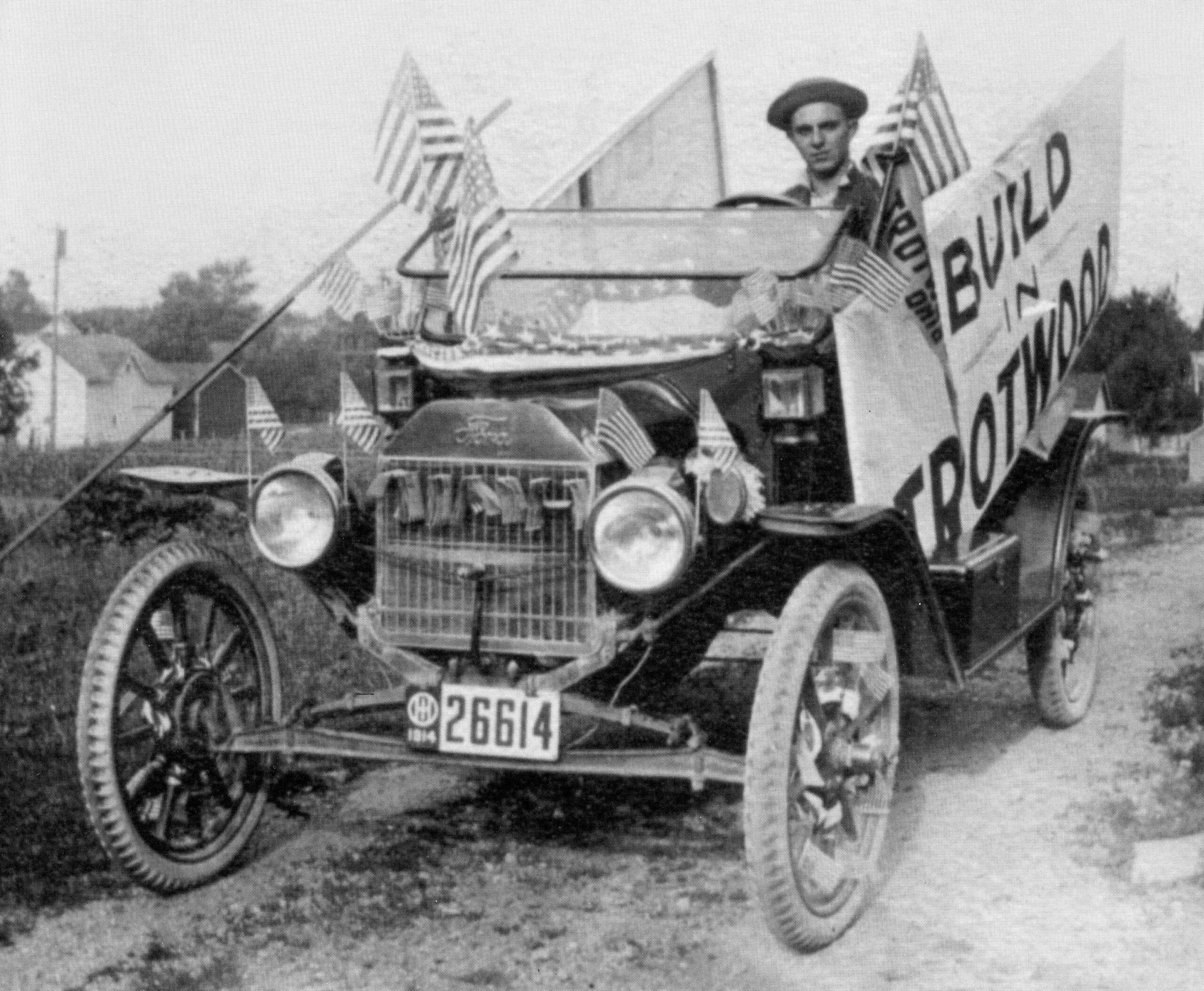TROTWOOD-MADISON HISTORICAL SOCIETY
Trotwood Madison Historical Society

Iams Homestead Museum (349 S. Broadway)
Dates & Hours of Operation
- June 16th | 2:00 p.m. - 4:00 p.m.
- July 21st | 2:00 p.m. - 4:00 p.m.
- August 18th | 2:00 p.m. - 4:00 p.m.
- September 22nd | 2:00 p.m. - 4:00 p.m.
THE HISTORY OF TROTWOOD

THE HISTORY OF TROTWOOD
The Trotwood-Madison community was born out of an entrepreneurial spirit, which is still alive today. Long ago, the famous mound builders known as the Hopewell Indians inhabited this southwest Ohio area. Their prehistoric relics and utensils have been found in Sycamore State Park as well as other areas of Madison Township. Later came the Shawnee and Miami Indians who were here when settlers began exploring and settling the Northwest Territory. In 1803 Ohio was the first state established in these new lands. Folklore has it Mrs. Iams, matriarch of the family that later started today's pet food empire, traded her baked goods with Indians for their rabbits and other game from the kitchen of the Iams House (built in 1847 and now home to the Trotwood Madison Historical Society). Also located on the Iams family homestead is an ancient bur oak tree which is the 2nd largest tree of this species in Ohio (according to Ohio Department of Natural Resources surveyor). Additionally, ODNR estimates the age of the tree to be over 500 years old. Now 121 feet tall, a tree of this size was probably a landmark long before Ohio was settled. It is a noble symbol of the perseverance and strength of the people here.
In 1824, Daniel Weymeyer began building a sawmill, gristmill and still house along the north fork of Wolf Creek. Due to financial difficulties the complex was sold at a sheriff's sale to Amos Higgins, the community's first successful entrepreneur. As the area's earliest known commercial enterprise the Mill operated until 1908. When Greenville & Miami Railroad (it became the Dayton & Union Railroad in 1861) and the Dayton & Western Railroads were completed across Madison Township in 1852-53; a pond on the present site of J.W. Devers & Son was a designated water stop for the steam engines. Seeing the commercial opportunities it presented, Amos Higgins built a railway station, tavern and inn just west of the Main St. railroad crossing and the stop became known as Higgins Station.
Entrepreneur Lewis R. Pfoutz was operating a general store at Post Town, about a mile south on Union Road, and he collected mail for his customers when he traveled to Dayton for supplies. Also recognizing the opportunities that the railroad created, Pfoutz built a store and set up business on the southeast corner of Main Street and Broadway where today's Olde Town 1912 train depot sits. In 1866, the year after the Civil War ended, Pfoutz applied for a post office franchise, only to discover there was already a Higgins P.O. in Ohio. Having just read Charles Dickens' David Copperfield, he submitted one of its character’s names, Aunt Betsy Trotwood, and the rest is history. To this day, Trotwood is the only city in the U.S. so named.
Pfoutz was appointed the area's first postmaster. In that same year a township school was built ½ mile south of Trotwood. With its Township government, an established post office and a nearby school in place, an era of great economic progress for the business community began. American Express Company opened an Office in Trotwood and a flurry of entrepreneurial and civic activity soon followed. In 1879 a printing office opened and in 1882 the first hotel was built. In 1893 a Madison Township high school began and in 1895 J.W. Devers & Son opened their blacksmith shop. In 1896 the Trotwood Lumber Yard opened, and the area's first grain elevator began in 1900. To this day J.W. Devers & Son is the community's oldest operating business.

The first example of planned development occurred in 1898 when the village of Trotwood was platted by Robert Pleasant and Nathan Worley who later had streets named for them. Trotwood was incorporated March 15, 1901 and at that time included 124.33 acres. In the early 1900s civic and business progress continued. In 1902 telephone service was made available in town. Also by 1902, Trotwood was one of the first villages to have water service. The Farmers and Citizens Bank opened for business in 1909, and when Vaniman Ford opened in 1910 the Village of Trotwood's population was 348 people. In 1912 electric service first became available here. With the advent of the nation's depression, the Trotwood-Madison community suffered like the rest of the nation. And yet in 1932 another entrepreneurial milestone occurred when Trotwood Trailers opened as one of the first recreational vehicle manufacturers in the U.S. making travel trailers and later mobile homes.
In 1950 the Village's population was 1,066 people. By then the nation's post World War II prosperity began taking hold, and the Salem Avenue Corridor began its ascent as one of Montgomery County's prime retail shopping attractions, a tradition that continues today. On May 13, 1969 the Village of Trotwood defeated a prolonged annexation attempt by the City of Dayton for control of the Salem Mall. Trotwood’s annexation of the mall area gave them jurisdiction of what was already Montgomery County's second largest regional shopping center. For the next quarter century the mall essentially became Trotwood's center of commercial and social interaction.
With its population having reached 6,997 the village of Trotwood became eligible for city status, and on February 13, 1971 Trotwood officially became a city. Jan Upp designed the City Flag with its five arrows symbolizing industry, business, housing, schools, and farming. In 1973 the City purchased the 3035 N. Olive Road site where City Hall now stands. By 1980 Trotwood's population had reached 7,802. In June 1981 the Madison Township Fire Department hired its first 6 full-time personnel, and by mid-1989 Trotwood Rescue had hired its first 6 full-time personnel.
To avoid the annexation of more parts of our township by Dayton, Madison Township chose to join with the City of Trotwood. The township and the city merged in 1996 to create one political entity. This merger increased the City of Trotwood to over 30 square miles in area. During the 1990’s Trotwood experienced a population high of 29,432. As with many Midwest cities in the “Rust Belt”, Trotwood has lost population. 23,070 is the current population for Trotwood. Our county seat, Dayton, has decreased in population by 17% since 2000.
(Source: https://www.biggestuscities.com/city/dayton-ohio)
Yet, the city has survived the fluctuation of financial markets, including the Great Recession of 2007 and most recently, the COVID-19 Recession of 2020. Both resulted in lost wages for citizens and hardships, such as housing foreclosures. In addition to financial catastrophes, Trotwood survived an EF-4 tornado May 27, 2019. Despite these challenges, the City of Trotwood displays the resilience of the character, Aunt Betsy Trotwood of Charles Dickens' David Copperfield.

Today, the City of Trotwood's leadership is paving the way for tomorrow's public-private success and a number of current business and building projects indicate a bright future. We are a community long defined by its entrepreneurial spirit and civic pride, commercial success and governmental excellence, small town charm and big city advantages.
OFFICERS
Patricia Hronek
President
Ph: 937-837-8485
Gene Whipp
Vice President
Ph: 937-837-9839
Claude Keeling
Treasurer
Ph: 937-837-5387
Email: cekeeling@msn.com
Nancy Fry
Secretary
Ph: 937-416-0999
Email: nfry812@yahoo.com
BOARD MEMBERS
Regina Kleinhenz
Memorabilia
Ph: 937-854-45405
Email: rakleinhenz@juno.com
Pam Jones
Ph: 937-837-9839
Email: pamtrotwood@frontier.com
Sally Frigo
Ph: 937-344-8265
Kathryn Smith
Ph: 937-416-2531
Email: tsmith1117@aol.com
